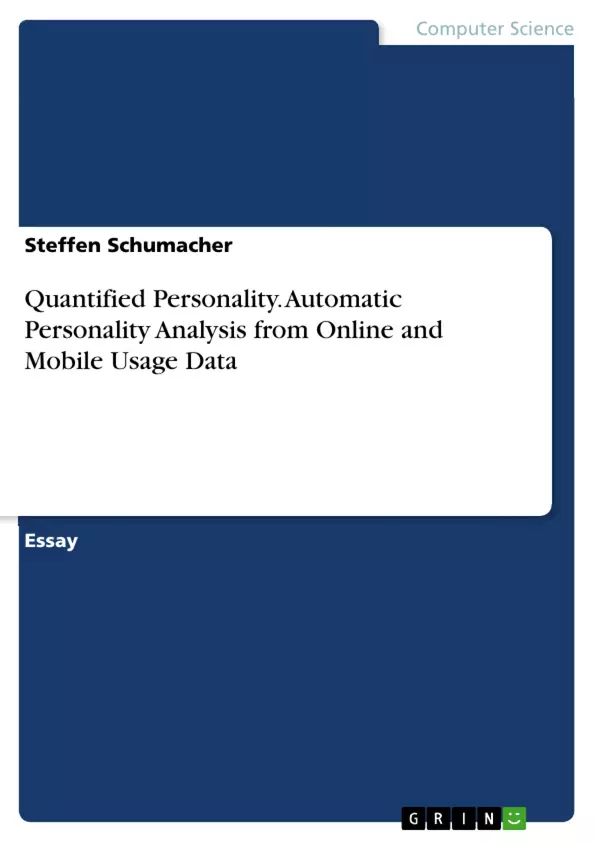Algorithms are instructions for the stepwise execution of a method. Social and cultural scientists but tend to broaden the meaning of this notion and use it as an umbrella notion for digital automatization in general. But computer programs contain non-algorithmic command syntax, also. Furthermore, algorithms may develop and change during implementation and use which makes talking about “the” algorithm being always identical with itself often difficult or impossible. A comprehension of the notion of algorithm too distant from that of computer science hinders the comprehensibility of social and cultural scientific analyses by computer scientists. On the other hand, these sciences shouldn’t confine their usage of this notion to that of the latter to be still able to deal with the phenomenon from a different perspective. (cf. Dourish 2016)
Automatic personality analysis doesn’t use data gathered by questionnaires administered to respondents, any more, but uses usage data which are generated by default and in different contexts, respectively. This is the big novelty of this field of investigation which led to the two articles published by Kosinski and Stillwell in the „Proceedings of the National Academy of Sciences of the United States of America“ in 2013 and 2015 being the most influential articles ever published in the “Proceedings” according to their Altmetric Score. These two articles dealt with the analysis of the personality of Facebook users using their Facebook likes. [...]
Inhaltsverzeichnis (Table of Contents)
- Automatic Personality Analysis
- Data and Methods
- Mobile Usage Data
- Facebook Likes
- The Big Five Personality Model
- Applications and Risks
- The Big Data Paradoxes
- The US Election Campaigns 2016
Zielsetzung und Themenschwerpunkte (Objectives and Key Themes)
This text explores the rapidly developing field of automatic personality analysis, examining its methods, applications, and potential risks. It delves into how digital usage data, particularly from smartphones and social media platforms like Facebook, can be analyzed to predict an individual's personality traits.
- The use of digital usage data for automatic personality analysis
- The accuracy and limitations of personality prediction based on online behavior
- The potential impact of this technology on advertising, political campaigning, and user control over their digital environment
- The ethical implications and potential for misuse of this type of data
- The role of the Big Five personality model in this field of research
Zusammenfassung der Kapitel (Chapter Summaries)
- Automatic Personality Analysis: This section introduces the concept of automatic personality analysis, highlighting its novelty in using digital usage data rather than traditional questionnaires. It also discusses the influence of the influential articles by Kosinski and Stillwell.
- Data and Methods: This section examines the two main types of data used in automatic personality analysis: mobile usage data and Facebook likes. It details the specific data points collected, the analytical methods employed, and the accuracy levels achieved in predicting personality traits.
- The Big Five Personality Model: The text explains the Big Five personality model, its widespread use in psychology, and its application in the context of automatic personality analysis. It also discusses the model's limitations, particularly regarding its stability over time.
- Applications and Risks: This section explores the potential applications of automatic personality analysis in various fields, including advertising, political campaigning, and the tailoring of online content to individual users. It also addresses the significant risks associated with this technology, including the potential for manipulation and invasion of privacy.
- The Big Data Paradoxes: This section discusses the three paradoxes of Big Data as outlined by Richards and King (2013), highlighting how they apply to the field of automatic personality analysis. These paradoxes relate to transparency, identity, and power imbalances.
- The US Election Campaigns 2016: This section delves into the controversial role of automatic personality analysis in the 2016 US election campaigns. It examines the claims made by Cambridge Analytica and the subsequent revelations about its methods and impact.
Schlüsselwörter (Keywords)
The central focus of this text is automatic personality analysis, exploring its methodologies and applications. Key terms include: digital usage data, mobile usage data, Facebook likes, personality prediction, Big Five personality model, psychographic analysis, data-driven research, ethical implications, and privacy concerns.
- Citation du texte
- Steffen Schumacher (Auteur), 2017, Quantified Personality. Automatic Personality Analysis from Online and Mobile Usage Data, Munich, GRIN Verlag, https://www.grin.com/document/383163



